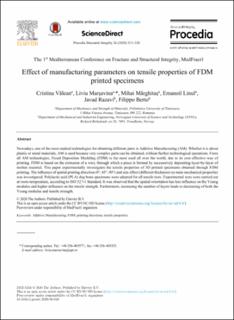| dc.contributor.author | Valean, C | |
| dc.contributor.author | Marsavina, L | |
| dc.contributor.author | Marghitas, M | |
| dc.contributor.author | Linul, E | |
| dc.contributor.author | Razavi, Seyed Mohammad Javad | |
| dc.contributor.author | Berto, Filippo | |
| dc.date.accessioned | 2021-01-20T12:23:26Z | |
| dc.date.available | 2021-01-20T12:23:26Z | |
| dc.date.created | 2020-12-01T10:03:17Z | |
| dc.date.issued | 2020 | |
| dc.identifier.citation | Procedia Structural Integrity. 2020, 26 313-320. | en_US |
| dc.identifier.issn | 2452-3216 | |
| dc.identifier.uri | https://hdl.handle.net/11250/2723913 | |
| dc.description.abstract | Nowadays, one of the most studied technologies for obtaining different parts is Additive Manufacturing (AM). Whether it is about plastic or metal materials, AM is used because very complex parts can be obtained, without further technological operations. From all AM technologies, Fused Deposition Modeling (FDM) is the most used all over the world, due to its cost-effective way of printing. FDM is based on the extrusion of a wire, through which a piece is formed by successively depositing layer-by-layer of molten material. This paper experimentally investigates the tensile properties of 3D printed specimens obtained through FDM printing. The influence of spatial printing direction (0°, 45°, 90°) and size effect (different thickness) on main mechanical properties was investigated. Polylactic acid (PLA) dog bone specimens were adopted for all tensile tests. Experimental tests were carried out at room temperature, according to ISO 527-1 Standard. It was observed that the spatial orientation has less influence on the Young modulus and higher influence on the tensile strength. Furthermore, increasing the number of layers leads to decreasing of both the Young modulus and tensile strength. | en_US |
| dc.language.iso | eng | en_US |
| dc.publisher | Elsevier | en_US |
| dc.rights | Attribution-NonCommercial-NoDerivatives 4.0 Internasjonal | * |
| dc.rights.uri | http://creativecommons.org/licenses/by-nc-nd/4.0/deed.no | * |
| dc.title | Effect of manufacturing parameters on tensile properties of FDM printed specimens | en_US |
| dc.type | Peer reviewed | en_US |
| dc.type | Journal article | en_US |
| dc.description.version | publishedVersion | en_US |
| dc.source.pagenumber | 313-320 | en_US |
| dc.source.volume | 26 | en_US |
| dc.source.journal | Procedia Structural Integrity | en_US |
| dc.identifier.doi | 10.1016/j.prostr.2020.06.040 | |
| dc.identifier.cristin | 1854662 | |
| dc.description.localcode | This article is available under the Creative Commons CC-BY-NC-ND license and permits non-commercial use of the work as published, without adaptation or alteration provided the work is fully attributed. | en_US |
| cristin.ispublished | true | |
| cristin.fulltext | original | |
| cristin.qualitycode | 1 | |

